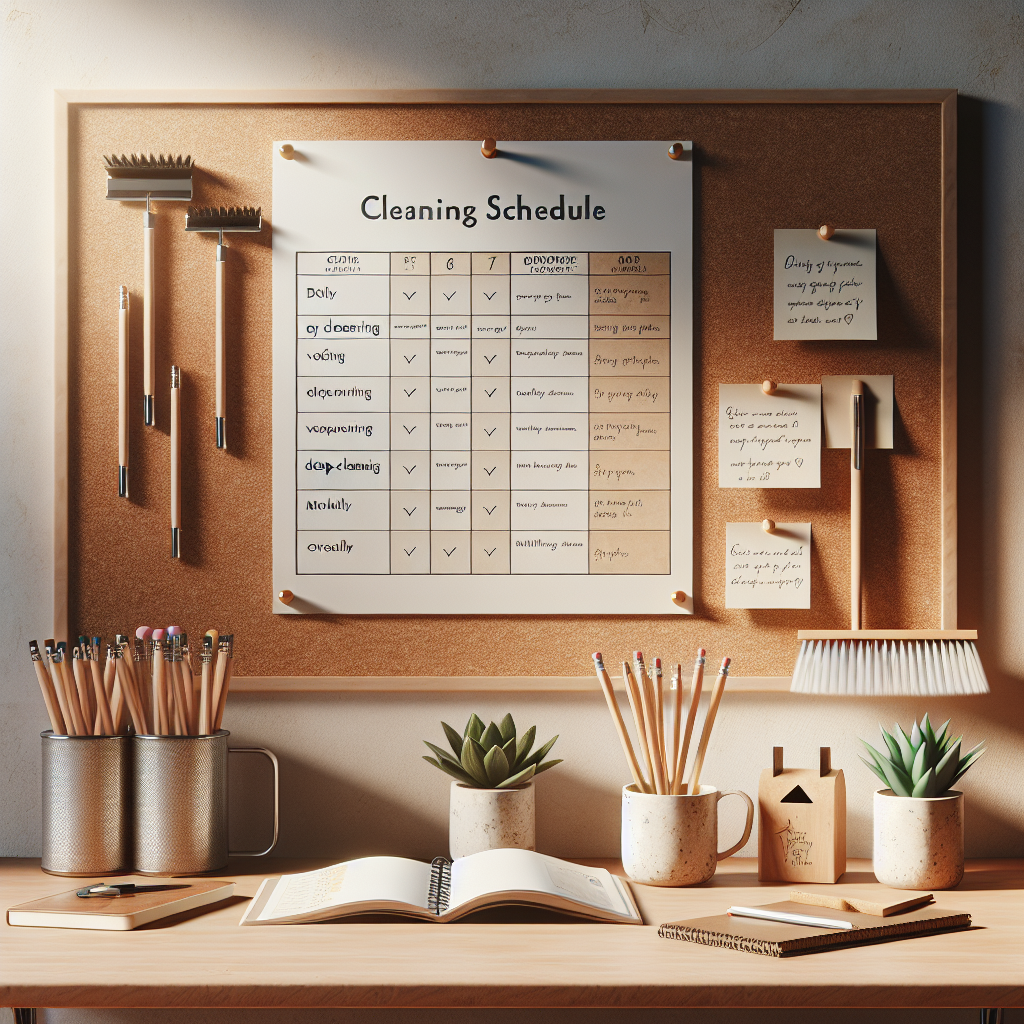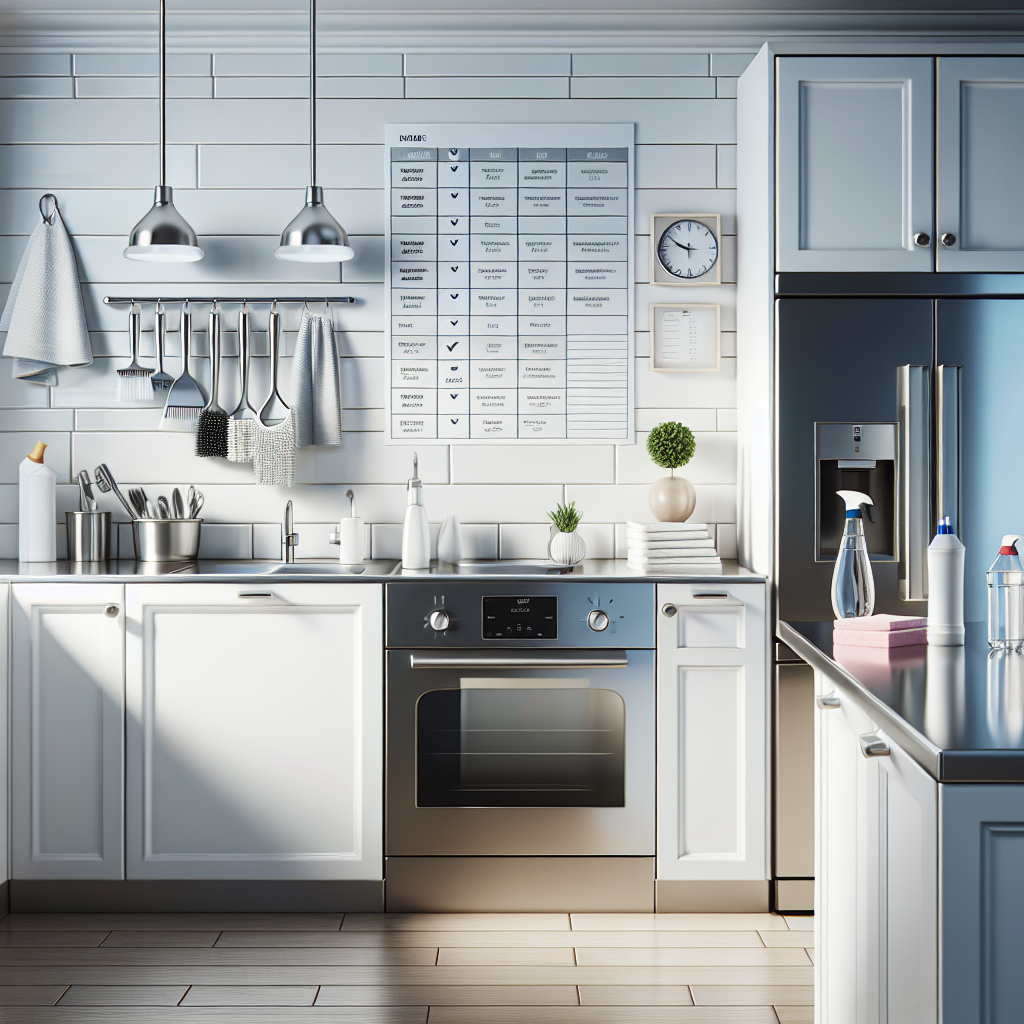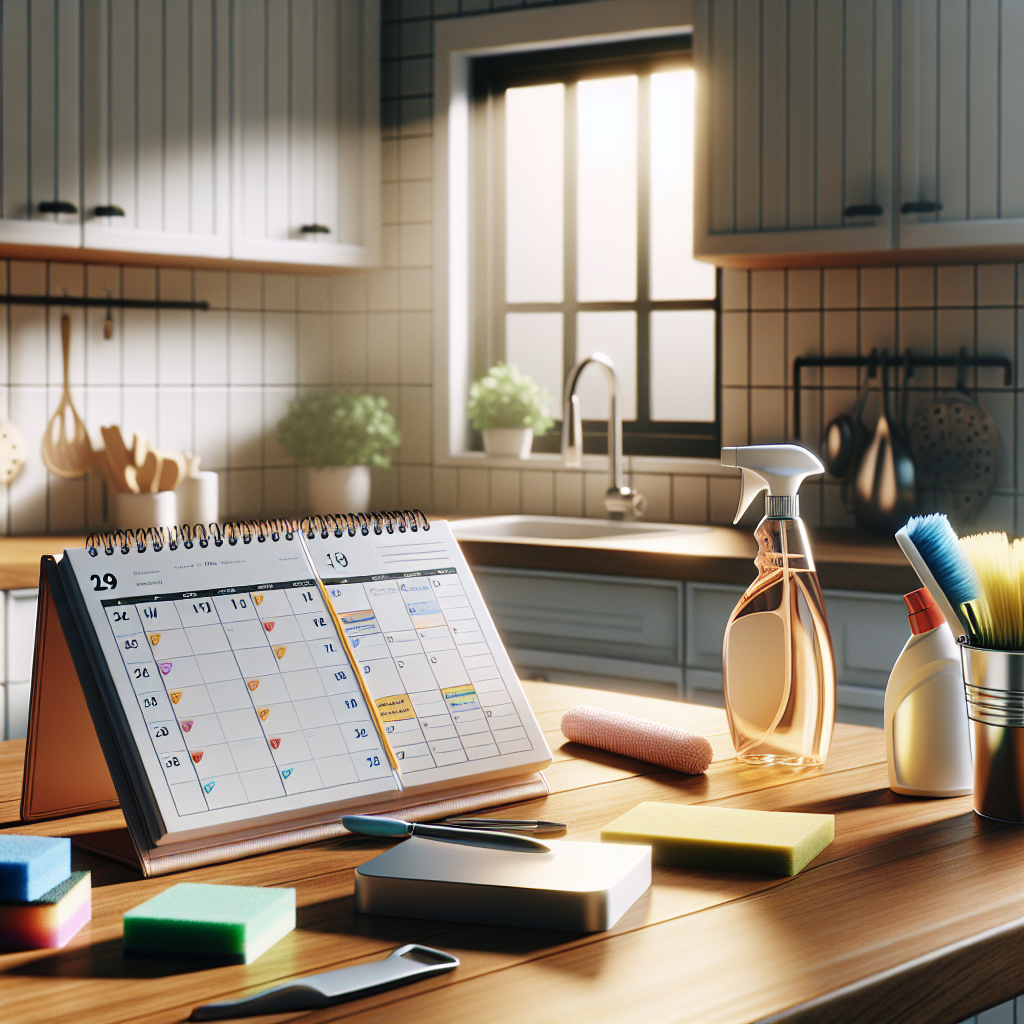- September 10, 2024
- Derek
What Should a Cleaning Schedule Include
Maintaining a clean and organized home can often feel like an overwhelming task, especially with busy schedules and daily responsibilities. However, having a well-structured cleaning schedule can make a world of difference. A cleaning schedule is essentially a plan that outlines what cleaning tasks need to be done and how often they should be tackled. This approach not only helps in keeping your home spotless but also ensures that no area is neglected over time.
At Tidyups Cleaning Service Inc, we understand the importance of a comprehensive cleaning schedule. Our experts have crafted cleaning plans that cater to both residential and commercial spaces, ensuring every corner is attended to with precision. A thoughtful cleaning schedule can include tasks such as daily tidying, weekly vacuuming, monthly deep cleaning, and seasonal maintenance, all tailored to fit your unique needs.
Implementing a cleaning schedule can bring numerous benefits, including improved hygiene, reduced stress, and a more inviting living environment. By breaking down tasks into manageable chunks, it becomes easier to maintain a pristine home without feeling overwhelmed. A well-organized schedule also ensures that cleaning becomes a part of your routine, making it less likely for dirt and clutter to accumulate.
Visit our website to learn more and get your FREE Quote today! Click here.
Key Components of a Cleaning Schedule

A well-structured cleaning schedule is composed of several key components that ensure all areas of your home or office are maintained regularly. Understanding these components can help you create a customized plan that suits your specific needs and lifestyle. Here are the essential elements that should be included in any effective cleaning schedule:
- Daily Tasks: These are the small, everyday chores that keep your space looking tidy. Tasks such as making beds, wiping down countertops, and doing the dishes fall under this category. By handling these tasks daily, you prevent clutter and dirt from building up.
- Weekly Tasks: These tasks require a bit more effort and are typically done once a week. Vacuuming carpets, mopping floors, cleaning bathrooms, and dusting surfaces are examples of weekly chores. Weekly tasks help to maintain a deeper level of cleanliness in your home.
- Monthly Tasks: To address areas that don’t require frequent attention, monthly tasks are included. Cleaning light fixtures, washing windows, and deep-cleaning appliances like ovens and refrigerators are essential monthly chores that contribute to a thorough cleaning regime.
- Seasonal Tasks: These are the more intensive tasks that are usually done a few times a year. Examples include cleaning gutters, washing curtains, and deep-cleaning carpets. Seasonal tasks ensure that even the most neglected areas receive the attention they need.
- Specialized Tasks: Depending on your individual needs, you may have specialized tasks that don’t fit into the daily, weekly, or monthly categories. These could include organizing closets, decluttering storage areas, or specific cleaning requirements based on seasonal changes or special events.
By incorporating these key components into your cleaning schedule, you can ensure that every part of your home or office is consistently maintained, creating a healthier and more pleasant environment for everyone.
Daily Cleaning Tasks to Include

Incorporating daily cleaning tasks into your routine is essential for maintaining a clean and organized living space. These tasks are designed to be quick and manageable, ensuring that your home remains tidy without requiring a significant time investment. Here are some fundamental daily cleaning tasks you should include in your schedule:
- Making Beds: Start your day by making your bed. This simple task can instantly make your bedroom look more orderly and set a positive tone for the day.
- Wiping Down Surfaces: Daily surface cleaning, such as wiping down kitchen countertops, dining tables, and bathroom sinks, helps prevent the buildup of grime and bacteria.
- Washing Dishes: Avoid letting dishes pile up by washing them after each meal. This keeps your kitchen clean and reduces the risk of attracting pests.
- Decluttering: Spend a few minutes each day decluttering common areas like the living room and kitchen. Put away items that are out of place to maintain a neat environment.
- Emptying Trash Bins: Regularly emptying trash bins, especially in the kitchen and bathroom, helps prevent unpleasant odors and keeps your home hygienic.
- Spot Cleaning Floors: Quickly sweep or vacuum high-traffic areas to remove dust, crumbs, and dirt. This prevents debris from spreading throughout your home.
- Bathroom Maintenance: A quick wipe down of bathroom fixtures and mirrors can keep your bathroom looking fresh and clean daily.
By incorporating these daily cleaning tasks into your routine, you can maintain a consistently tidy and inviting home with minimal effort. Regular upkeep not only makes your living space more pleasant but also reduces the need for more intensive cleaning sessions.
Weekly Cleaning Tasks for Efficiency

While daily cleaning tasks help maintain a basic level of cleanliness, weekly cleaning tasks are essential for tackling areas that require more thorough attention. These tasks are designed to ensure that your home remains in top condition and that dirt and grime do not accumulate over time. Here are some key weekly cleaning tasks to include in your schedule:
- Dusting: Dust all surfaces, including furniture, shelves, and decorative items. Don’t forget to dust hard-to-reach areas such as ceiling fans, light fixtures, and baseboards.
- Vacuuming Carpets and Rugs: A thorough vacuuming session once a week helps remove embedded dirt, pet hair, and allergens from carpets and rugs, enhancing indoor air quality.
- Mopping Floors: After vacuuming, mop hard floors in areas like the kitchen, bathrooms, and entryways to remove any lingering dirt and disinfect the surfaces.
- Cleaning Bathrooms: Give your bathroom a deeper clean by scrubbing the toilet, shower, bathtub, and sink. Don’t forget to clean mirrors and replace or sanitize bathroom mats.
- Changing Bedding: Replace bed linens and pillowcases to maintain freshness and hygiene. This task is crucial for preventing dust mites and allergens.
- Cleaning Appliances: Wipe down kitchen appliances such as the microwave, oven, and refrigerator. Pay special attention to the interior of the microwave and the exterior handles of all appliances.
- Emptying and Cleaning Trash Cans: Take out the trash and give the bins a good clean to prevent odor and bacterial growth.
- Wiping Down Doors and Handles: High-touch areas like door handles, light switches, and remote controls should be sanitized weekly to prevent the spread of germs.
By incorporating these weekly cleaning tasks into your routine, you can ensure that your home remains clean and sanitary. Regular deep cleaning helps prolong the life of your furniture, appliances, and other household items, ultimately contributing to a healthier living environment.
Monthly Deep Cleaning Activities

While daily and weekly cleaning tasks handle the immediate and visible dirt, monthly deep cleaning activities target the less obvious areas that accumulate grime over time. These tasks are crucial for maintaining overall cleanliness and hygiene in your home. Here are some essential monthly deep cleaning activities to consider:
- Cleaning Inside Appliances: Once a month, clean the inside of your refrigerator, oven, and microwave. Remove shelves and drawers to wash them separately, and wipe down the interior surfaces to eliminate food residues and spills.
- Washing Windows: Clean the inside and outside of your windows to remove dust, dirt, and streaks. Don’t forget to clean the window sills and tracks, which can collect grime and debris.
- Deep Cleaning Carpets and Upholstery: Use a carpet cleaner or hire a professional service to deep clean your carpets and upholstery. This helps remove embedded dirt, stains, and allergens that regular vacuuming can’t reach.
- Dusting Vents and Baseboards: Dust and clean air vents, baseboards, and other often-overlooked areas. This prevents dust buildup, which can affect air quality and contribute to allergies.
- Wiping Down Walls and Ceilings: Use a damp cloth or a mop to wipe down walls and ceilings, especially in areas prone to moisture and grease, such as the kitchen and bathroom.
- Cleaning Light Fixtures: Remove and clean light fixtures and lampshades to get rid of dust and cobwebs. This can also improve the brightness of your lighting.
- Organizing and Cleaning Closets: Take time to declutter and organize your closets. Wipe down shelves and vacuum the floors to maintain a tidy and accessible space.
- Sanitizing Mattresses: Vacuum your mattresses and consider using a mattress cleaner to eliminate dust mites and allergens. Rotate or flip the mattress to ensure even wear.
Incorporating these monthly deep cleaning activities into your routine ensures that your home stays fresh and inviting. Deep cleaning not only enhances the aesthetic appeal of your living space but also promotes a healthier environment by reducing allergens and bacteria buildup.
Customizing Your Cleaning Schedule

Customizing your cleaning schedule is essential to meet the unique needs of your home and lifestyle. While standard cleaning tasks provide a good foundation, tailoring your schedule ensures that all areas receive the attention they require. Here are some tips on how to customize your cleaning schedule:
- Assess Your Home’s Needs: Take a walk through your home and identify areas that need more frequent cleaning. High-traffic areas like the kitchen and living room may require more attention than guest rooms or storage spaces.
- Consider Your Lifestyle: If you have young children or pets, you might need to clean more frequently to manage spills, pet hair, and other messes. Tailor your schedule to accommodate these specific needs.
- Set Realistic Goals: Be honest about how much time you can dedicate to cleaning each week. It’s better to have a manageable schedule that you can stick to rather than an overly ambitious one that leads to burnout.
- Prioritize Tasks: Determine which tasks are non-negotiable and must be done regularly, and which can be done less frequently. Prioritize tasks based on their impact on your home’s cleanliness and your family’s health.
- Use a Cleaning Checklist: A checklist helps you organize tasks and ensures nothing is overlooked. Customize it to include daily, weekly, monthly, and seasonal tasks specific to your home.
- Be Flexible: Life can be unpredictable, so it’s important to remain flexible with your cleaning schedule. If you miss a task one week, try to catch up the following week without stressing too much.
By customizing your cleaning schedule, you create a plan that works for you and your home, ensuring a consistently clean and welcoming environment. A tailored approach not only makes cleaning more manageable but also more effective.
Visit our website to learn more and get your FREE Quote today! Click here.
